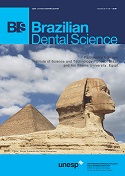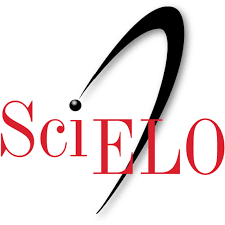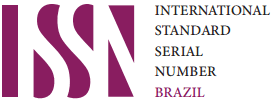Correlation Between Dental Caries And Salivary Albumin In Adult Population In Chennai: An In Vivo Study
DOI:
https://doi.org/10.14295/bds.2019.v22i2.1686Resumo
Objective: To evaluate the relationship between dental caries and levels of salivary albumin in unstimulated saliva of adults between the age group of 18 and 40 years from Chennai with varying caries experience as determined by their Decayed Missing Filled Teeth (DMFT) scores. Material and Methods: The study was conducted on 60 healthy adult subjects with age group between 18 and 40 years. The healthy subjects without any chronic diseases, gingival or periodontal problems were selected. The patients were divided into four groups according to DMFT status as Group 1, DMFT 0; Group2, DMFT 1?5; Group 3, DMFT 6?10; and Group 4, as DMFT above 10. Unstimulated saliva samples were collected from each subjects and the salivary albumin levels were estimated using the bromocresol green method (albumin colorimetric test). The obtained data was statistically analysed using one?way ANOVA and Tukey`s Honestly Significant Difference test. Results: The mean salivary albumin levels for the groups 1, 2, 3 and 4 were .086 ± .009 mg/ml, .083 ±.006 mg/ml, .070 ± .008 mg/ml and .056 ±.009 mg/ml respectively. There was an increase in incidence of caries with decrease in salivary albumin level. There was a statistically significant difference among the groups except group 1 and 2. Conclusion: There is a significant relationship between the salivary albumin level and the incidence of dental caries. An increase in incidence of caries with decrease in salivary albumin levels was seen suggestive of its importance in maintenance of tooth integrity.
Keywords
Caries; Caries incidence; Dental caries; Salivary albumin; Salivary protein.
Keywords
Caries; Caries incidence; Dental caries; Salivary albumin; Salivary protein.
Downloads
Downloads
Arquivos adicionais
Publicado
Como Citar
Edição
Seção
Licença
TRANSFERÊNCIA DE DIREITOS AUTORAIS E DECLARAÇÃO DE RESPONSABILIDADE
Toda a propriedade de direitos autorais do artigo "____________________________________________________________________" é transferido do autor(es) para a CIÊNCIA ODONTOLÓGICA BRASILEIRA, no caso do trabalho ser publicado. O artigo não foi publicado em outro lugar e não foi submetido simultaneamente para publicação em outra revista.
Vimos por meio deste, atestar que trabalho é original e não apresenta dados manipulados, fraude ou plágio. Fizemos contribuição científica significativa para o estudo e estamos cientes dos dados apresentados e de acordo com a versão final do artigo. Assumimos total responsabilidade pelos aspectos éticos do estudo.
Este texto deve ser impresso e assinado por todos os autores. A versão digitalizada deverá ser apresentada como arquivo suplementar durante o processo de submissão.




























